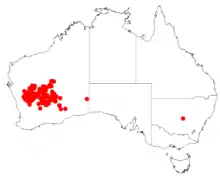| Western blue mulga | |
|---|---|
| Scientific classification | |
| Kingdom: | Plantae |
| Clade: | Tracheophytes |
| Clade: | Angiosperms |
| Clade: | Eudicots |
| Clade: | Rosids |
| Order: | Fabales |
| Family: | Fabaceae |
| Subfamily: | Caesalpinioideae |
| Clade: | Mimosoid clade |
| Genus: | Acacia |
| Species: | A. caesaneura |
| Binomial name | |
| Acacia caesaneura Maslin & J.E.Reid | |
 | |
| Occurrence data from AVH | |
| Synonyms[1] | |
| |
Acacia caesaneura, commonly known as western blue mulga, is a shrub or tree belonging to the genus Acacia and the subgenus Juliflorae that is endemic to western Australia.
Description
The multi-stemmed shrub with a height of 3 to 4 m (9.8 to 13.1 ft) eventually mature to a tree with a height of 6 to 10 m (20 to 33 ft) with an obconic habit with dense crowns. The densely haired branchlets have discrete resinous ribs towards the apices. Like most species of Acacia it has phyllodes rather than true leaves. The evergreen and variable phyllodes are straight and dimidiate to sickle shaped recurved and usually with a narrowly oblong to elliptic shape. The phyllodes are not rigid and have a length of 2 to 8 cm (0.79 to 3.15 in) and a width of 2 to 12 mm (0.079 to 0.472 in) with many longitudinal nerves.[2]
Distribution
It is native to an area of the Goldfields-Esperance and Mid West regions of Western Australia.[3] The bulk of the population is found from around Yalgoo in the west to around Meekatharra in the north down to around Kalgoorlie in the south extending to around the northern edge of the Nullarbor Plain in the east. A. caesaneura if often situated on plains or undulating country growing in red-brown sandy loam to clay soils sometimes over hardpan as a part of Acacia shrubland or woodland communities.[2]
See also
References
- ↑ "Acacia caesaneura Maslin & J.E.Reid | Plants of the World Online | Kew Science". Plants of the World Online. Retrieved 11 July 2023.
- 1 2 "Acacia caesaneura Maslin & J.E.Reid". Wattle - Acacias of Australia. Lucid Central. Retrieved 22 March 2020.
- ↑ "Acacia caesaneura". FloraBase. Western Australian Government Department of Biodiversity, Conservation and Attractions.